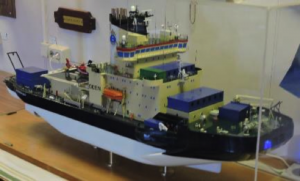27 August 2014, by Dan Wolfe:

Scale model of the Oden
Here is a quick overview of the Oden. As you can see from this scale model, and if you Googled the Oden online, it is a very unique looking ship. I have been on a number of icebreakers during my career, and I’d have to say this is the most interesting and well equipped so far. Most icebreakers have a tall super structure allowing them to scan for openings or leads in the ice. For people onboard the Oden, this translates into eight stories requiring multiple trips up and down the various flights of stairs every day. Another feature that stands out is its square bow designed for maximum efficiency in the ice. This same feature makes for a terrible ride in the open ocean, even during light seas. Most icebreakers roll a lot. The Oden jolts you and your equipment as waves slip under the bow or sides.
We have just entered the ice for the first time this leg. It is quite a site and sensation. It started out with very small chunks of ice floating by, but quickly changed to larger pieces and then flows. Depending on where you are on the ship you get a different feeling. From our cabin/stateroom you can feel the larger pieces giving an initial jolt followed by a scrapping noise as pieces slide along the side of the ship. When you are outside you can hear the cracking of the ice and watch as the flows tip over, often revealing small fish hiding under the ice. Something I learned this morning is that the ice flows under the ship past the screws. The screws have protective covers, but smaller pieces get through these covers making the whole ship feel and sound like a giant washing machine as the screws chew up the ice and spit it out behind the ship. Normally icebreakers are designed to deflect the ice around the ship and away from the screws. We have gone from the Marginal Ice Zone now into the main pack. This doesn’t mean we are surrounded by 100% ice cover, just that there are more large ice flows and less open water. I’ve even seen a few pressure ridges; places where two flows have come together from opposite directions pushing the ice up and down creating mounds of ice. These ridges are primarily older and harder ice that the ship will steer around. Now that we are in the ice, everyone is awaiting our first polar bear or walrus siting.
